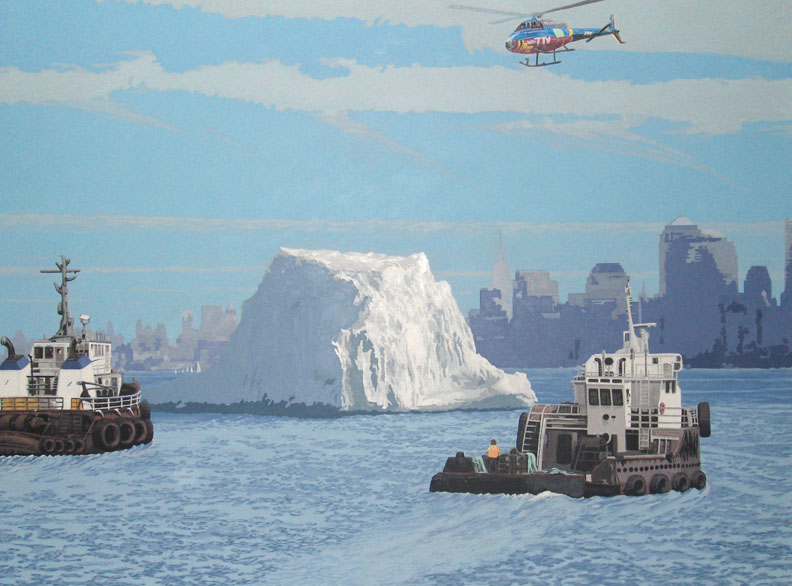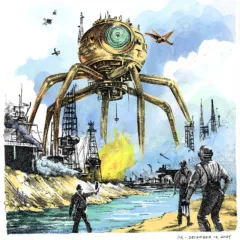I’m sorry to report that the end of the world will be broadcast on television. We will sit at home and watch as images are beamed into our living rooms, bedrooms, and banks of screens in sports bars. We’ll be eating popcorn, making love and getting drunk while trying to pick off someone from the opposite sex, chowing down burgers and quaffing watery drafts. All the while images will flash: Some oilwell aflame somewhere, some building imploding somewhere, thousands of pilgrims wiped out by a wall of water on some beach. We’ll watch and wait our turn.

Many artists have trod this familiar path, evoking doomsday scenarios of hellfire, brimstone, and Harry Potter-like narratives of death and destruction. But they don’t have the power of the news, which is the preferred medium for this final chapter and its interruptive ad blips. However, now that we have environmental catastrophe on our hands (and our minds), we might turn our attention to the paintings of Herman James. Informed, he says, “by the environmental degradation created by our global emissions into the atmosphere,” his works are large panel-like depictions of eyewitness Armageddon.
James also calls these canvases “loaded landscapes,” and indeed they are. “On the Incoming Tide,” a 2009, oil on linen, canvas at 54 x 75 inches (above), performs like the wall-sized flat-screen televisions we demand. We are there and not there. An iceberg the size of contemporary municipal sculpture is floating about in the lower Hudson River. As if it were a lost whale, tugboats converge upon it to hear its song and rescue it; a television helicopter circles above like a hawk, angling for winning images to feed the world. Treated a bit like the OJ Simpson escape chase on the killer highways of Los Angeles, this crime scene is a bit more romantic with its powdery blue skies and crisp waters, the world’s most famous skyline (sans the Twin Towers) holding it all together and giving it the importance and grace of a truly potent autumn-in-our-lives moment. Yet James’ realism holds it all in abeyance with a distance and somewhat cartoon (read: acrylic) color that is both flat and cold – which is how I prefer my news: Screw “fair and balanced” and “we report you decide.” Is that how we read “The Old Man And The Sea” ? No, this is Walter Kronkite beaming out from Disneyland: “Tomorrow, a solar flare is set to burn up California.”
Mr. James reports: “Now, of course, this is a fantasy of a global warming scenario. As you see the berg is quite large and really, given that about 90% of the mass of any piece of floating ice is submerged, it would be impossible for such a chunk to get this far upstream. The Hudson at its depth is only 55 feet.”
The truth about icebergs – and most things that float, this being the metaphor for most everything on the surface of our lives – is that they are only about one-tenth visible as commonly accepted. According to the new source of all information of value, Wikipedia, “icebergs generally range from one to 75 meters (three to 250 ft) above sea level and weigh 100,000 to 200 000 tons.” So, Mr. James’ daughter was right when she said, “Daddy… the picture would just not have any impact if it were really real.”
Doesn’t really matter because the truth is global melt is on the way into town, and coursing up (or down) the Hudson. It will be a slow adventure and because of that, we’ll have live pictures for you at five.
Herman James and Whitey Flagg open their exhibition CONSUMPTION / CONSEQUENCE at Dutch Kills Gallery in Long Island City, New York on Saturday, April 11, 6 – 9. (Exhibition from April 11 – May 3, 2009). Carbon emissions, ozone levels and energy flow, as well as other statistical documentation of ongoing threats to the environment will be on view. For more information: Dutch Kills Gallery, Herman James, Whitey Flagg.
Matthew Rose is an artist and writer based in Paris, France. His next exhibition is Confessions, Obsessions & Indiscretions at Soma Gallery, Cape May, NJ, opening May 9, 2009.









